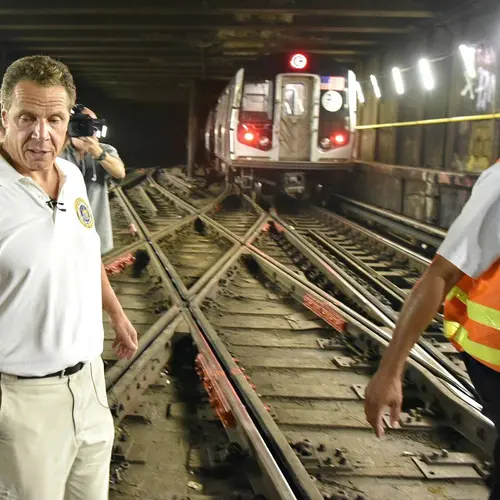Cuomo gives Con Ed one year to repair the subway’s power system

Photo © Governor Andrew Cuomo/Flickr
Just in the past month, power problems caused 32,000 subway delays, prompting Governor Cuomo to direct “Con Edison to take significant and immediate actions to improve the subway’s power reliability and prevent future service failure,” according to a press release. Less than two months after declaring a “state of emergency” for the subway system, Cuomo’s given Con Ed and the MTA one year to identify and repair the problems, the most comprehensive power review ever done, leaving them on the hook to inspect 470 manholes, 1,100 boxes, and 221 power substations at street level and 1,100 energy distribution rooms, 300 signal relay rooms, 15,000 track circuits, 11,000 signals, 13,750 insulated joints, 11,000 trip stops, 220 interlockings, and 1,800 switch machines below ground. The cost? It’s not yet been officially calculated, but Con Ed chairman John McAvoy says it’s likely to be tens of millions of dollars.

“To repair the MTA, we must also focus on the services that the MTA relies upon,” Governor Cuomo said. “The number one necessity is a reliable power supply. That must be provided by Con Edison. Over the years there have been band aids placed all over the system. We need to fundamentally upgrade the entire system. I thank Con Edison for their cooperation.”
As the Times explains, Cuomo was first prompted to overhaul the power system after an event at the Seventh Avenue and 53rd Street station on April 21st. Both the power and backup power failed during the morning rush hour, leading to delays on nearly half the system’s lines and stranding many riders underground for hours. An investigation by the state also included two other recent power-related incidents. On May 7th a Con Ed transformer failed at a transmission substation, the change in voltage affecting the DeKalb station. Two days later, the same station lost signal power, the cause of which is still being determined since both Con Ed and MTA lacked the equipment to monitor power at the location.
Though official findings from the investigation haven’t been released, according to the Governor’s office, the outages stem from four problem areas:
- Loss of power
- Frequent surges in power that force the system to go into failsafe mode (shutdown)
- Frequent power dips which cause equipment to fail
- An insufficient power back up system in the event of a power failure


Governor Cuomo touring a distribution room at Columbus Cirle. Photos © Governor Andrew Cuomo/Flickr
The New York State Public Service Commission (PSC) will oversee the work, which will be spread across the system’s 600+ miles of tracks and be performed seven days a week. Their timeline gives six months for “priority projects,” nine months for “second priority,” and 12 months for total completion.
Currently, routine inspections of the power system are done every five years, but they’ll now be done annually. As the Times explains, the biggest issues stem from the nearly 90-year-old, antiquated signal system. As it stands now, “the power from Con Ed flows to an M.T.A. distribution room, where it then goes into the system, powering everything from signals to track equipment. For safety reasons, the signal system is designed with a fail-safe that is tripped when there are fluctuations in power that are read as an anomaly.” So even a “relatively routine spike” can turn a track light red, resulting in significant delays. Part of the MTA and Con Ed’s task is to find a safe alternative to this system.
It’s important to note that the power overhaul is not part of the MTA’s 30-day emergency plan, which focuses on the the system’s decades-old equipment and subway cars, nor is it included in this project’s $800 million budget. Mayor de Blasio has been staunch in his stance that the city will not fund half of this cost as the Governor has requested, and on Monday, he proposed taxing the wealthiest one percent of New Yorkers to fund the repairs. The feud is likely to heat up even more now, as it’s unclear how the new work’s cost will be split up.
RELATED:
































